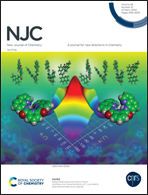High-performance CH3NH3PbI3:PbS nanorod-based photodetectors fabricated using a slot die technique
Abstract
Herein, we report a hydrothermal method to synthesize pure-phase stoichiometric PbS nanorods using different molar concentrations of Pb(NO3)2 and Na2S. Furthermore, using an indigenously developed slot-die coating technique, CH3NH3PbI3:PbS (MAPI:PbS) nanocomposite films were deposited on a TiO2-coated glass substrate. The XRD analysis revealed that the incorporated PbS nanorods in MAPI do not disturb its crystal structure. Furthermore, the thickness, roughness, surface coverage, and optical band gap of MAPI:PbS nanocomposite thin films showed critical dependence on the length of the incorporated PbS nanorods. The results revealed that at an optimized Pb(NO3)2 : Na2S molar concentration ratio (0.05 : 0.15), the MAPI:PBR-2 nanocomposite film has the lowest thickness of ∼922 nm and RMS surface roughness of ∼43 nm along with an optimum band gap of ∼1.52 eV. Lastly, we fabricated pristine MAPI and MAPI:PbS nanocomposite-based photodetectors using a slot die coating technique on a TiO2-coated FTO substrate. The photodetector fabricated at a Pb(NO3)2 : Na2S molar concentration ratio of 0.05 : 0.15 (MAPI:PBR-2) showed a high detectivity of ∼1.24 × 1010 Jones, photoresponsivity of ∼39.79 mA W−1, external quantum efficiency of ∼89.79% with a fast rise time of ∼0.07 s, and decay time of ∼0.20 s. The improved photodetector properties observed in the MAPI:PBR-2-based photodetector can be attributed to the high optical absorbance and enhanced charge collection at the MAPI:PbS/HTL interface.



 Please wait while we load your content...
Please wait while we load your content...